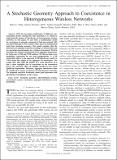| dc.contributor.author | Pinto, Pedro C. | |
| dc.contributor.author | Giorgetti, Andrea | |
| dc.contributor.author | Win, Moe Z. | |
| dc.contributor.author | Chiani, Marco | |
| dc.date.accessioned | 2011-11-10T16:01:29Z | |
| dc.date.available | 2011-11-10T16:01:29Z | |
| dc.date.issued | 2009-09 | |
| dc.date.submitted | 2009-08 | |
| dc.identifier.issn | 0733-8716 | |
| dc.identifier.other | INSPEC Accession Number: 10847188 | |
| dc.identifier.uri | http://hdl.handle.net/1721.1/67001 | |
| dc.description.abstract | With the increasing proliferation of different communication devices sharing the same spectrum, it is critical to understand the impact of interference in heterogeneous wireless networks. In this paper, we put forth a mathematical model for coexistence in networks composed of both narrowband (NB) and ultrawideband (UWB) wireless nodes, based on fundamental tools from stochastic geometry. Our model considers that the interferers are spatially scattered according to a Poisson field, and are operating asynchronously in a wireless environment. We first determine the statistical distribution of the aggregate interference for both cases of NB and UWB emitters. We then provide error probability expressions for two dual configurations: 1) a NB victim link subject to the aggregate UWB interference, and 2) a UWB victim link subject to the aggregate NB interference. The results show that while the impact of a single interferer on a link is often negligible due to restrictions on the transmitted power, the aggregate effect of multiple interferers may cause significant degradation. Therefore, aggregate interference must be considered to ensure coexistence in heterogeneous networks. The proposed analytical framework shows good agreement with physical-level simulations of the system. | en_US |
| dc.description.sponsorship | Portuguese Science and Technology Foundation (grant SFRH-BD-17388-2004) | en_US |
| dc.description.sponsorship | MIT/Army Institute for Soldier Nanotechnologies | en_US |
| dc.description.sponsorship | United States. Office of Naval Research (Presidential Early Career Award for Scientists and engineers (PECASE) N00014-09-1-0435) | en_US |
| dc.description.sponsorship | National Science Foundation (U.S.) (Grant ECS-0636519) | en_US |
| dc.description.sponsorship | Charles Stark Draper Laboratory (Reduced Complexity UWB Communication Techniques Program) | en_US |
| dc.description.sponsorship | European Commission (FP7 ICT integrated project Co- Existing Short Range Radio by Advanced Ultra-WideBand Radio Technology (EUWB) grant 215669)t) | en_US |
| dc.description.sponsorship | Institute of Advanced Study (Natural Science and Technology Fellowship) | en_US |
| dc.language.iso | en_US | |
| dc.publisher | Institute of Electrical and Electronics Engineers | en_US |
| dc.relation.isversionof | http://dx.doi.org/10.1109/jsac.2009.090922 | en_US |
| dc.rights | Article is made available in accordance with the publisher's policy and may be subject to US copyright law. Please refer to the publisher's site for terms of use. | en_US |
| dc.source | IEEE | en_US |
| dc.title | A Stochastic Geometry Approach to Coexistence in Heterogeneous Wireless Networks | en_US |
| dc.type | Article | en_US |
| dc.identifier.citation | Pinto, P.C. et al. “A stochastic geometry approach to coexistence in heterogeneous wireless networks.” Selected Areas in Communications, IEEE Journal on 27.7 (2009): 1268-1282. © 2011 IEEE. | en_US |
| dc.contributor.department | Massachusetts Institute of Technology. Laboratory for Information and Decision Systems | en_US |
| dc.contributor.approver | Win, Moe Z. | |
| dc.contributor.mitauthor | Win, Moe Z. | |
| dc.contributor.mitauthor | Pinto, Pedro C. | |
| dc.relation.journal | IEEE Journal on Selected Areas in Communications | en_US |
| dc.eprint.version | Final published version | en_US |
| dc.type.uri | http://purl.org/eprint/type/JournalArticle | en_US |
| eprint.status | http://purl.org/eprint/status/PeerReviewed | en_US |
| dspace.orderedauthors | Giorgetti, A.; Win, M.Z.; Pinto, P.C.; Chiani, M. | en |
| dc.identifier.orcid | https://orcid.org/0000-0002-8573-0488 | |
| mit.license | PUBLISHER_POLICY | en_US |
| mit.metadata.status | Complete | |
